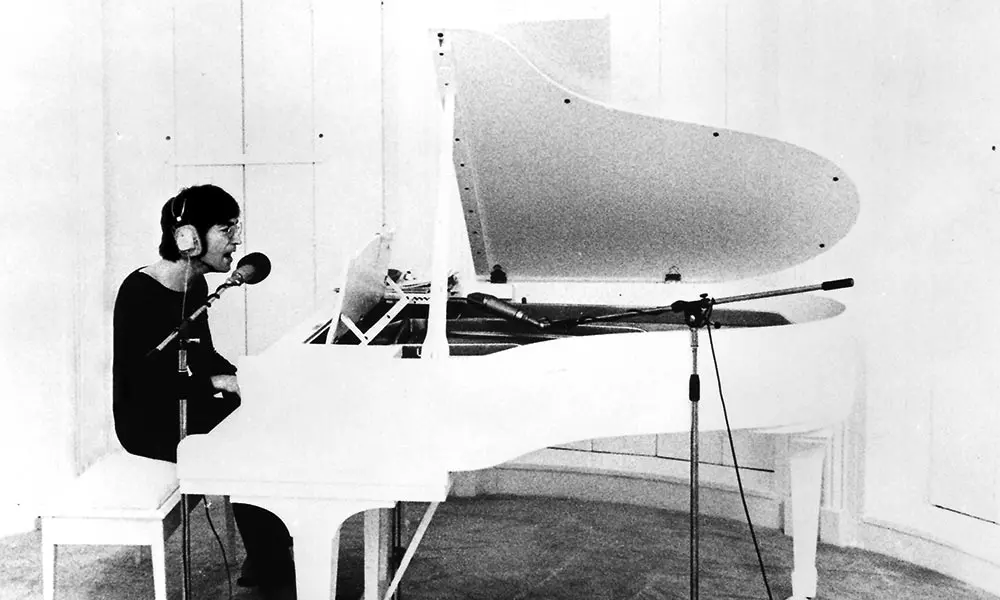
In times of trouble and grief, there is one song that millions of people turn to for inspiration and solace: John Lennon and Yoko Ono’s “Imagine.”
Leading musicians often reach for the song in moments of need. When Stevie Wonder was told of the death of Senator John McCain in August 2018, during a concert in Atlanta, he broke into a beautiful version of Lennon’s masterpiece that was released as a single on October 11, 1971. Though the song was banned from radio in the immediate aftermath of 9/11, Neil Young recognized its potency, singing it at a memorial concert, America: Tribute To Heroes. Coldplay performed a version after the terrorist attacks in Paris in 2015. Following discord around North Korea in 2018, “Imagine” was the natural choice for a group of Korean musicians to perform at the opening ceremony of the Winter Olympics. A new 4K remaster of the iconic video, with remastered audio from 2018’s Imagine: The Ultimate Collection box set, further heightens the song’s impact today.
“An ad campaign for peace”
John Lennon described the song as “an ad campaign for peace”, and it is no surprise that his moving anthem is such a beacon for those who long for global harmony. “Imagine,” written in March 1971 during the Vietnam War, has become a permanent protest song and a lasting emblem of hope.
When his widow Yoko Ono, along with son Sean Lennon, was in New York’s Central Park at the start of September 2018 to celebrate the US Postal Service’s release of a stamp honoring the late Beatle, the song that she made reference to was “Imagine,” which charts above any Beatles material on the official Phonographic Performance Limited list of streamed songs.
What is it that makes “Imagine” such a brilliant recording? From the opening bars of Lennon playing the piano, the song arouses a stirring emotional response. There is also the clever way the track is produced – by John and Yoko, along with the maestro Phil Spector – which brings out the best in Lennon’s plaintive, vulnerable vocals. The subtly beautiful strings, written by Lennon, orchestrated by Torrie Zito and performed by The Flux Fiddlers, play their part in making this song the creative peak of John and Yoko’s professional partnership.
A love song to humanity
The song was first inspired by Ono’s poetry in her 1964 book, Grapefruit. In the poem “Cloud Piece” Yoko wrote, “Imagine the clouds dripping, dig a hole in your garden to put them in.” John Lennon later said: “‘Imagine’ should be credited to Lennon/Ono. A lot of it – the lyric and the concept – came from Yoko, but in those days, I was a bit more selfish, a bit more macho, and I sort of omitted her contribution, but it was right out of Grapefruit.”
The first line of this love song to humanity – “Imagine there’s no heaven” – was a provocative statement at the time, a direct challenge to organised religion from a man who had previously joked that The Beatles were “more popular than Jesus.” The song continues to challenge the listener, asking them to imagine a world with no possessions, no religion or even countries – nothing, indeed, “to kill or die for.”
“Imagine” crystallizes Lennon and Ono’s philosophy at a critical point in their life, as the newlyweds sought a way to communicate their vision to the world. The Imagine album came after a tumultuous period during which Lennon and Ono, had held a series of bed-in protests that grabbed the world’s attention. The pair had also visited Coventry Cathedral to plant acorns in a demonstration for peace at a site that had been bombed during the Second World War.
This looking out at the world was complemented by a fresh voyage of inwards discovery. In the mid-to-late 60s, experimentation with psychedelics led Lennon to seek other ways of expanding his consciousness, including Transcendental Meditation studies led by the Maharishi Mahesh Yogi in Rishikesh, India, with whom The Beatles stayed in 1968. But Lennon, the eternal seeker, would never be comfortable with just one mode of thought – as Yoko later put it, “John was a very religious person belonging to no denomination.” He had already been vilified by American Christians who burned Beatles albums in the wake of his “more popular than Jesus” statement, and after the Maharishi was accused of improprieties, Lennon was quick to leave the ashram.
“There’s a lot of good in Christianity but you’ve got to learn the basics of it, and the basics from the Eastern beliefs, and work them together for yourself,” Lennon later concluded. Indeed, as he sang in “God”: “I just believe in me/Yoko and me/And that’s reality.” The song was released in 1970, during a period when Yoko, drawing on her philosophical studies, began to conduct therapy on the ex-Beatle. These informal sessions were followed with primal therapy courses that Lennon and Yoko undertook together, led by the psychologist Arthur Janov. The results were apparent on the John Lennon/Plastic Ono Band album, also released in 1970 – a raw, cathartic album that paved the way for the clarity of thought that characterises Imagine.
Imagine, which also included the highly political song “Gimme Some Truth”, was an invitation to imagine the impossible; a plea for people to show spiritual unity and to abandon divisions of religion and nationality. It was also a reflection of Lennon’s state of mind at the time. Drummer Alan White recalled that it was recorded in a genial atmosphere, with everyone socializing happily at the recording studio: “John Lennon loved the way the record was turning out, so he was very happy.”
“We’re carrying that torch”
On December 5, 1980, John Lennon gave his final interview. Looking back on his seminal song, he said: “We’re not the first to say ‘Imagine no countries’ or ‘Give peace a chance,’ but we’re carrying that torch, like the Olympic torch, passing it hand to hand, to each other, to each country, to each generation… and that’s our job. Not to live according to somebody else’s idea of how we should live – rich, poor, happy, not happy, smiling, not smiling, wearing the right jeans, not wearing the right jeans.”
The album was recorded across February, June, and July 1971, and footage survives of Lennon trying out versions of the song on the piano and singing it in different styles.
When work began on “Imagine,” the song was conceived “without melody”, like “a childlike street chant.” When Lennon cut the final version in the studio, it featured bass from old Beatles cohort Klaus Voormann, plus drums and a string arrangement.
The new Imagine: The Ultimate Collection box set celebrating Lennon’s most famous album, to be released by Universal Music on October 5, includes a never-before-heard demo of the title track, more in keeping with his original instruction to Spector that “it should be just a piano song.” Ono’s liner notes for the album say that “‘Imagine’ was created with immense love and concern for the children of the world.”
“We should be talking about violence in society”
When “Imagine” was released, John Lennon said that the world was too focused on trivialities and “the thing we should be talking about is the violence that goes on in this society.” It reached No. 1 following Lennon’s murder in December 1980 and entered the UK charts again in 2012 after Emeli Sandé recorded a cover for the 2012 London Olympics. Still today, it is played at every New Year’s ceremony in Times Square in New York.
“Imagine” may be wrapped in sweetness and strings, but when you take the orchestration away, the underlying concept remains radical and anti-establishment – or, as Lennon put it, “It’s ‘Working Class Hero’ with sugar on it.” Yoko’s assertion that, “All these instructions are for people for how to spend eternity, because we have lots of time,” has, however, proved prescient. Decades after its original release, this popular music masterpiece, a model of simplicity, continues to inspire people of all races and creeds, offering the listener a momentary respite of hope in a troubled world, especially in the beautiful lines:
You may say I’m a dreamer
But I’m not the only one
I hope some day you’ll join us
And the world will be as one
GIMME SOME TRUTH. The Ultimate Mixes. can be bought here.
source https://www.udiscovermusic.com/stories/imagine-john-lennons-provocative-anthem-became-hymn-peace/

